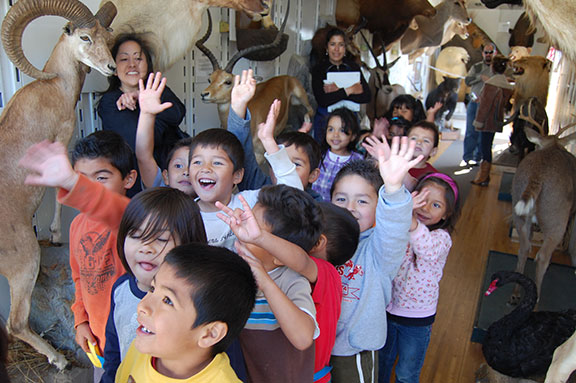Sensory Safari
Sensory Safari offers a unique opportunity to children and adults. It is very special for the visually impaired who focus learning through touch and hearing. Children and adults are escorted by knowledgeable “safari guides” through a variety of touchable displays of animal, fish and bird mounts, skins, skulls and horns. The guides describe the animals and their habitats and behaviors as participants touch and sometimes even hug the displays. Sensory Safaris can be held year-around and be located virtually anywhere, giving children and adults a hands-on wildlife education.



Sensory Safari Program Continues to Inspire
Sensory Safari is a rewarding and moving program whereby children and adults everywhere, but especially individuals with visual impairment, are offered a unique opportunity to “see” wildlife through the sense of touch. This is done by utilizing thousands of donated and borrowed animal mounts, skins, skulls, and horns.
The first Sensory Safari took place in 1991, when Mr. Robert Easterbrook, Sr. provided both visually impaired and sighted children the opportunity to enjoy the beauty of wildlife through the sensation of touch.
It has been growing ever since. SCI member volunteers now assist 60,000 to 70,000 participants per year through a network of full mounted displays, table displays, and mobile Sensory Safari trailers, describing the animal’s size, sounds, habitats, and behaviors.
In 2010, SCI chapters reported 154 Sensory Safaris and, with the help of volunteers, escorted many thousands of students, visually-impaired children, homeless children/adults, senior citizens and disabled individuals through displays owned by 46 of SCI’s North American Chapters, as well as the mobile Sensory Safari trailers owned by 22 U.S. chapters.
The program drew the attention of the National Federation of the Blind (NFB), which asked SCI Foundation to host a Sensory Safari at its annual convention. It was such a success that, in 1997, the NFB signed a memorandum of understanding with SCI to host Sensory Safari at future conventions.
While most Sensory Safaris have been temporary exhibits, some schools for the blind, wildlife zoos, natural history museums, and libraries are now requesting and establishing permanent displays, including:
- Natural History Museum of Las Vegas, Nevada
- Schools for the blind in Washington, Louisiana, Alabama, Tennessee, Mississippi, New Mexico, South Carolina, Indiana, and Minnesota
- Lincoln Folsom Zoo, Lincoln, Nebraska
- Children’s Science Center at the Brevard Museum, Brevard, Florida
- “Conservation Station” at Dickerson Park Zoo, Springfield, Missouri
Whether touching the inside of an alligator’s long snout, feeling the serpentine neck of a giraffe, stroking the thick fur of a bear, or hearing the game calls of waterfowl and big game, the participants get to experience what even many sighted people have not.

Since 2000, SCI Foundation has provided more than $80 million to promote science-based conservation through wildlife research, capacity building in governments, youth and teacher education, and humanitarian programs that show the importance of the hunting community in society around the world. Growth of SCI Foundation has continued to gain momentum through charitable donations from SCI members and direct grants from local chapters and the SCI organization. Throughout the world, SCI’s approximately 50,000 members and 190 chapters contribute time, talent, and financial support to local, national, and international projects.
